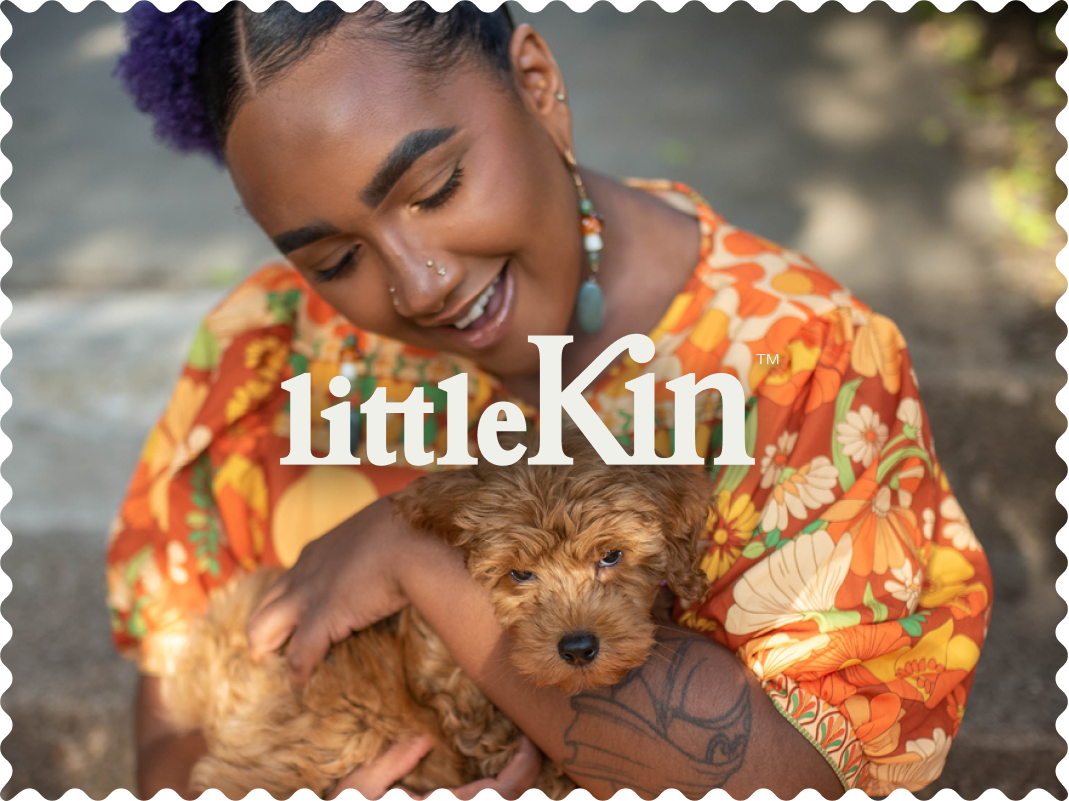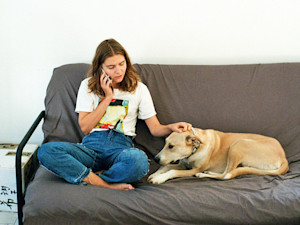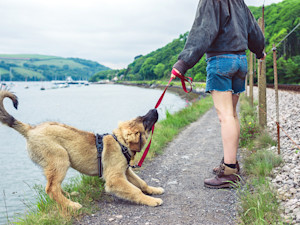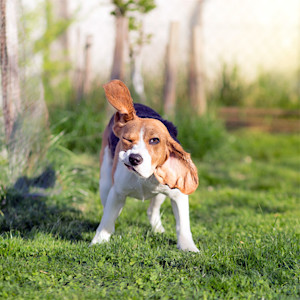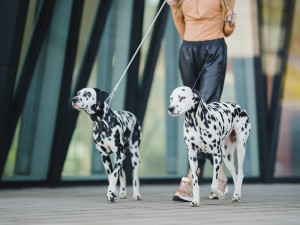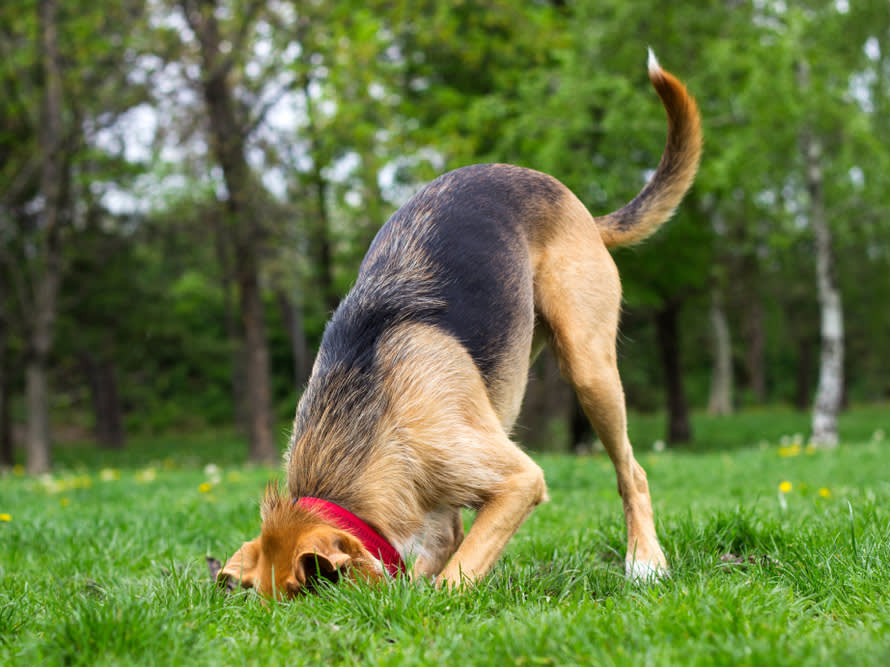
Share Article
One Christmas, as a super-special treat, I wrapped up one of those crunchy pig’s ears for my rescue dog Lucy. She tore the paper with her teeth as I helped her reveal her present inside. Then she did something I was totally not expecting…
The pig’s ear firmly clamped in her mouth, she went and did her good girl sit by the backdoor and patiently waited there for me to let her out into the garden. She dug a little hole in the soil, placed the ear inside of it and used her nose to cover it up with dirt.
I watched on in fascination, like a David Attenborough documentary was unfolding before my eyes. Why didn’t she want to eat the pig’s ear? Was she saving it for later? Did she love or loathe the treat?
And she did it again when she was having a sleepover at my parent’s house. My mum gave her a little bone-shaped chew and she took it out to the patio garden and arranged it underneath some stones. “Look what Lucy did!” my mum exclaimed in a WhatsApp pic, “so cute! Why did she do it?”
I didn’t know, but I thought it would be good to call on some experts to investigate what’s really going on. Lucy doesn’t bury her treats very often, but should I be worried when she does? Let’s dig into it… (sorry).
Where does digging behaviour come from?
First of all, this digging behaviour actually has a proper term: “caching,” dog trainer at Bone Ball Barkopens in new tab, Jennifer Billot informs me.
“And the art of ‘food caching’ – storing food away for later consumption – isn’t just used by dogs. Many other animals do it too, including birds, squirrels – think ‘squirrelling away’ for later – and foxes, amongst many others,” explains Rima Chehlaoui, behaviourist at Even Better Dogs K9 Behaviour and Trainingopens in new tab.
“Burying is an intrinsic behaviour,” Rima continues, which means that it’s a “natural behaviour” for dogs. “The behaviour is likely inherited from their ancestors who would have needed to bury food to preserve it from scavengers.”
“Caching can be driven by motivation to store food or other highly prized items so your dog can find them again at a later time,” agrees Jennifer.
Rima also reassures me that it can also simply be for fun! “Dogs love to dig and bury things,” she tells me.
What items do dogs usually bury?
Basically, dogs will bury anything they find “valuable”, says Rima. (Of course, I’m thrilled that Lucy thought that about her present!). The item your dog chooses to bury could be anything from a chew or a toy to any household objects they like. “Sometimes, dogs will bury things we find a bit silly, but they like the item and find it to be valuable. Of course, it isn’t up to us to choose what is valuable to them.”
Also, dogs don’t just bury things in the garden. “You might find your dog grabbing your slippers and trying to bury them in the corner of the sofa under a load of cushions,” laughs Jennifer.
Does this burying behaviour indicate a problem?
“It’s only an issue if it becomes compulsive or causes excessive damage,” says Rima. It could also hurt their paws if they do it too much – see your vet, if so.
“Sometimes your dog might bury something to get your attention – maybe they know you will react or start to play with them,” says Rima. But there’s nothing wrong with this! Join in and have some fun.
However, burying can also indicate boredom – “maybe your dog finds the act of digging calming and soothing as it can provide mental and physical stimulation,” says Rima.
“Some medical conditions also cause stress, which may in turn cause burying behaviours,” continues Rima. “In addition, pregnant females sometimes present burying and digging behaviours as they nest and prepare for the arrival of their litter.”
Jennifer explains that burying items can be a response to stressful situations. “For example, if your dog has had something stressful happen in their environment, then they’re unlikely to want to eat there, this is why they might take their food away to hide for later,” she explains, this then creates their own safe area to keep coming back to.
Rima also tells me that some breeds are more prone to digging and burying than others – “including but not limited to Terriers, Dachshunds and Beagles. That said, all dogs are individuals, caveats Rima, so they should be treated as such.
Should we stop our dogs from burying things?
Rima assures me that it’s OK to let the digging behaviour happen if there is not an issue with it.
Jennifer encourages all pet parents with dogs who like to cache items to provide them with a couple of spots to fulfil this innate desire – “both inside the house and outside in the garden,” she advises. “Inside, this could be a pile of old towels and blankets, away from the busy areas of the house. Or, you could section off a corner of the garden or convert a kid’s sandpit into a burying area.”
Rima agrees, although she also notes that a dog can search in several different locations before they settle on one spot to dig and bury their chosen treasure – “and the digging pit you created especially for them may not be it,” she says.
Rima also encourages you to ask yourself the following questions: does your dog have enough enrichment? Are you providing enough species-appropriate mental stimulation – especially if they’re a super-active breed?
Sometimes I make Lucy a ‘treat towel’. I’ll lay one of her towels out on the floor, sprinkle treats in it and roll it up. She uses her nose to sniff out the treats and her paws to ‘dig’ at the towel. You could also try filling up a Kong, or using an interactive puzzle toy.
Does spaying/neutering help?
“Spaying or neutering is rarely the answer for a behavioural issue,” says Jennifer. “This will be on a case by case basis.”
“Spaying or neutering usually only helps with hormone based/sexually based behaviours,” says Rima. “So, for example marking and roaming, amongst other things. But there is no guarantee it will help with other behaviour issues.” In fact, Rima says that in certain circumstances, it can actually exacerbate behaviours, so seek advice from your vet.
Anything else we should think about when it comes to digging?
You might see more burying in rescue dogs, says Rima – “especially those who’ve experienced neglect, abuse or a scarcity situation. Perhaps they had to compete for food as a street dog or stray.” But Rima says that this behaviour may diminish as the dog settles in. If a dog is very traumatised, Rima advises seeking out the help of a professional force-free behaviourist.
One warning, though, if your dog buries any type of food, “it is generally not healthy for your dog to eat them at a later date as it can cause gastric issues such as vomiting and diarrhoea,” warns Rima.
Sometimes Lucy also digs into the carpet or her bed or even makes a little hole for herself to sit in in the garden, so I ask Rima if that is linked to the same kind of behaviour. “Dogs are den animals so that’s part of nesting or denning,” she replies – it’s all about getting comfy.
Again Rima tells me that it’s nothing to be concerned about – “it’s natural,” she says. “When it comes to our dogs, no behaviour is black and white,” continues Rima, “they are nuanced and complex beings, so we should look at other things around them, too – for example environment, disposition, routine and lots of other things.”
Of course, if you don't want your dog digging in your flower beds, it's worth fencing them off or making sure their recall is on point.
Now get out there with your pup and dig for treasure! Let’s go, Lucy!

Alice Snape
Alice Snape is a freelance writer and editor whose work has featured in Cosmopolitan, Metro, Red, Vice, amongst other publications. Her rescue dog Lucy is the love of her life – probably because she’s an anxious weirdo like her. You’ll likely find them both curled up in bed – Alice’s favourite place to write from – or out having an adventure together in the park…
Related articles
Why Is My Dog Obsessed With Snapping the Air?
If your dog is snapping at the air, it could be more than just play
![]()
Does Your Dog Understand When You’re On the Phone?
And do they want to join in?
![dog greeting a woman at the door]()
Why Is My Dog Obsessed With Sniffing Me Every Time I Come Home?
From your mood to where you’ve been, your dog’s sniffing tells them a lot about you
![a picture of a big fluffy puppy biting their lead by the side of a lake. Their owner in jean shorts]()
Puppy Lead Training 101
This article (and a whole bunch of patience) is all that stands between you stepping out with your new puppy into the wide world
![Beagle dog shaking body and ears]()
Why is My Dog Obsessed With ‘Shaking It Off’, Even When They’re Dry?
It’s more than just a quirky habit
![Owner walking two Dalmatians downtown]()
How To Stop a Dog From Pulling on the Lead
Tug of war every time you head for a walk is not the one
